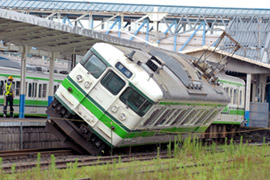IAEA to visit Japan quake reactor
Nuclear inspectors to check damage at nuclear plant hit by powerful earthquake.

The magnitude 6.8 quake on July 16 killed 10 people and injured more than 1,000, although none as a result of leaks at the nuclear plant itself.
‘Unease’
On Thursday, the head of the International Atomic Energy Agency (IAEA), Mohamed ElBaradei, offered to dispatch global experts to inspect the damage, but Japan rejected the offer saying it could handle the checks on its own.
Local officials then petitioned the central government to accept the inspectors, saying the plant’s problems and leaks had stirred “great unease” among residents and were tarnishing Japan‘s reputation overseas.
“We will work closely with the IAEA to carry out the investigation,” Yasuhisa Shiozaki, Japan‘s Chief Cabinet Secretary told reporters on Monday.
He said Japan would cooperate “toward ensuring safety in other parts of the world that are also prone to earthquake.”
Malfunctions
 |
| The magnitude 6.8 quake caused widespread damage and disruption [EPA] |
The earthquake triggered a wave of malfunctions and damage at the plant, including a fire that charred an electrical transformer, planks that toppled into a pool of spent nuclear fuel and the knocking over of some 400 barrels of atomic waste.
The problems were capped by news that radioactive water had sloshed out of a tank and was flushed out to sea, and that radioactive material was vented into the air in two separate instances.
The problems were exacerbated yet further by the long delays in the plants operators informing the public of what had happened.
Officials at the Kashiwazaki plant have acknowledged they had not foreseen such a powerful quake hitting the facility.
They also repeatedly underreported its impact after it hit.
The damage caused by the quake prompted the Japanese government to order the plant to be shuttered indefinitely until its safety can be confirmed.